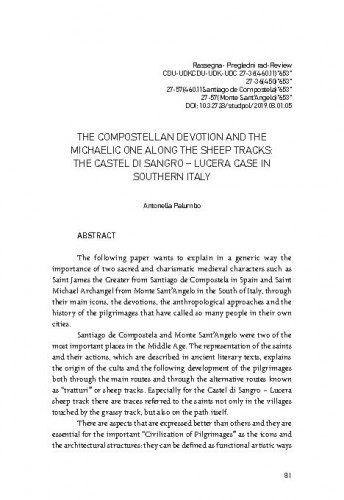The following paper wants to explain in a generic way the importance of two sacred and charismatic medieval characters such as Saint James the Greater from Santiago de Compostela in Spain and Saint Michael Archangel from Monte Sant’Angelo in the South of Italy, through their main icons, the devotions, the anthropological approaches and the history of the pilgrimages that have called so many people in their own cities. Santiago de Compostela and Monte Sant’Angelo were two of the most important places in the Middle Age. The representation of the saints and their actions, which are described in ancient literary texts, explains the origin of the cults and the following development of the pilgrimages both through the main routes and through the alternative routes known as “tratturi” or sheep tracks. Especially for the Castel di Sangro – Lucera sheep track there are traces referred to the saints not only in the villages touched by the grassy track, but also on the path itself. There are aspects that are expressed better than others and they are essential for the important “Civilization of Pilgrimages” as the icons and the architectural structures: they can be defined as functional artistic ways to communicate to all people not only in the past. So, historical and artistic studies, but also anthropological and literature fields of study are the relevant methodological approach to better figure out the history of the compostellan and michaelic pilgrimages.
Sažetak

 Studia Polensia : rivista del Dipartimento di studia in lingua italiana : 8,1(2019) / capo redattore Eliana Moscarda Mirković.
Studia Polensia : rivista del Dipartimento di studia in lingua italiana : 8,1(2019) / capo redattore Eliana Moscarda Mirković.